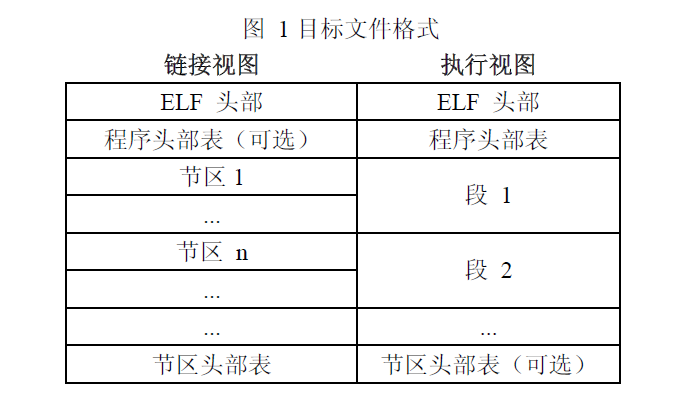关于ELF文件的详细介绍,推荐阅读: ELF文件格式分析 —— 滕启明。
ELF文件由ELF头部、程序头部表、节区头部表以及节区4部分组成。

通过objdump工具和readelf工具,可以观察ELF文件详细信息。
ELF文件加载过程分析
从编译、链接和运行的角度,应用程序和库程序的链接有两种方式。一种是静态链接,库程序的二进制代码链接进应用程序的映像中;一种是动态链接,库函数的代码不放入应用程序映像,而是在启动时,将库程序的映像加载到应用程序进程空间。
在动态链接中,GNU将动态链接ELF文件的工作做了分工:ELF映像的载入与启动由Linux内核完成,而动态链接过程由用户空间glibc实现。并提供了一个“解释器”工具ld-linux.so.2。
Linux内核中,使用struct linux_binfmt结构定义一个ELF文件加载
/* binfmts.h */
struct linux_binfmt {
struct list_head lh;
struct module *module;
int (*load_binary)(struct linux_binprm *, struct pt_regs * regs);
int (*load_shlib)(struct file *);
int (*core_dump)(struct coredump_params *cprm);
unsigned long min_coredump; /* minimal dump size */
};
load_binary函数指针指向的是一个可执行程序的处理函数。我们研究的ELF文件格式的定义如下:
/* binfmt_elf.c */
static struct linux_binfmt elf_format = {
.module = THIS_MODULE,
.load_binary = load_elf_binary,
.load_shlib = load_elf_library,
.core_dump = elf_core_dump,
.min_coredump = ELF_EXEC_PAGESIZE,
};
Linux内核将这个数据结构注册到可执行程序队列,当运行一个可执行程序时,所有注册的处理程序(这里的load_elf_binary)逐一前来认领,若发现格式相符,则载入并启动该程序。
static int load_elf_binary(struct linux_binprm *bprm, struct pt_regs *regs)
{
struct file *interpreter = NULL; /* to shut gcc up */
unsigned long load_addr = 0, load_bias = 0;
int load_addr_set = 0;
char * elf_interpreter = NULL; //"解释器"
/*......*/
struct {
struct elfhdr elf_ex;
struct elfhdr interp_elf_ex;
} *loc; //elf头结构
loc = kmalloc(sizeof(*loc), GFP_KERNEL);
/*......*/
/* Get the exec-header */
loc->elf_ex = *((struct elfhdr *)bprm->buf); //bprm->buf是内核读的的128字节映像头
retval = -ENOEXEC;
/* First of all, some simple consistency checks */
if (memcmp(loc->elf_ex.e_ident, ELFMAG, SELFMAG) != 0) //查看文件头4个字节,判断是否为"\177ELF"
goto out;
if (loc->elf_ex.e_type != ET_EXEC && loc->elf_ex.e_type != ET_DYN) //是否为可执行文件或共享库?
goto out;
/*......*/
/* Now read in all of the header information */
/*......*/
retval = kernel_read(bprm->file, loc->elf_ex.e_phoff, // kernel_read读取整个程序头表
(char *)elf_phdata, size);
/*......*/
for (i = 0; i < loc->elf_ex.e_phnum; i++) { //这个大for循环功能是加载"解释器"
if (elf_ppnt->p_type == PT_INTERP) { //PT_INTERP指"解释器"段
/* This is the program interpreter used for
* shared libraries - for now assume that this
* is an a.out format binary
*/
/*......*/
retval = kernel_read(bprm->file, elf_ppnt->p_offset, //根据位置p_offset和大小p_filesz将"解释器"读入
elf_interpreter, //这里读入的其实是"解释器"名字"/lib/ld-linux.so.2"
elf_ppnt->p_filesz);
/*......*/
/* make sure path is NULL terminated */
retval = -ENOEXEC;
if (elf_interpreter[elf_ppnt->p_filesz - 1] != '\0')
goto out_free_interp;
interpreter = open_exec(elf_interpreter); //打开"解释器"
retval = PTR_ERR(interpreter);
if (IS_ERR(interpreter))
goto out_free_interp;
/*
* If the binary is not readable then enforce
* mm->dumpable = 0 regardless of the interpreter's
* permissions.
*/
would_dump(bprm, interpreter);
retval = kernel_read(interpreter, 0, bprm->buf, //读入128字节的"解释器"头部
BINPRM_BUF_SIZE);
/*......*/
/* Get the exec headers */
loc->interp_elf_ex = *((struct elfhdr *)bprm->buf);
break;
}
elf_ppnt++;
}
/*......*/
/* Some simple consistency checks for the interpreter */
if (elf_interpreter) { //对"解释器"段的校验
/*......*/
}
/*......*/
for(i = 0, elf_ppnt = elf_phdata;
i < loc->elf_ex.e_phnum; i++, elf_ppnt++) {
int elf_prot = 0, elf_flags;
unsigned long k, vaddr;
if (elf_ppnt->p_type != PT_LOAD) //搜索类型为"PT_LOAD"的段(需载入的段)
continue;
if (unlikely (elf_brk > elf_bss)) {
/*......*/
}
/*......*/
}
error = elf_map(bprm->file, load_bias + vaddr, elf_ppnt,
elf_prot, elf_flags, 0); //建立用户虚拟地址空间与映射文件某连续区间的映射
/*......*/
}
/*......*/
if (elf_interpreter) { //如果要载入"解释器"(都是静态链接的情况)
unsigned long uninitialized_var(interp_map_addr);
elf_entry = load_elf_interp(&loc->interp_elf_ex,
interpreter,
&interp_map_addr,
load_bias); //载入"解释器"映像
if (!IS_ERR((void *)elf_entry)) {
/*
* load_elf_interp() returns relocation
* adjustment
*/
interp_load_addr = elf_entry;
elf_entry += loc->interp_elf_ex.e_entry; //用户空间入口地址设置为elf_entry
}
if (BAD_ADDR(elf_entry)) {
force_sig(SIGSEGV, current);
retval = IS_ERR((void *)elf_entry) ?
(int)elf_entry : -EINVAL;
goto out_free_dentry;
}
reloc_func_desc = interp_load_addr;
allow_write_access(interpreter);
fput(interpreter);
kfree(elf_interpreter);
} else { //有动态链接存在
elf_entry = loc->elf_ex.e_entry; //用户空间入口地址设置为映像本身地址
if (BAD_ADDR(elf_entry)) {
force_sig(SIGSEGV, current);
retval = -EINVAL;
goto out_free_dentry;
}
}
kfree(elf_phdata);
/*......*/
start_thread(regs, elf_entry, bprm->p); //修改eip与esp为新的地址,程序从内核返回应用态时的入口
/*......*/
/* error cleanup */
/*......*/
}
我们这样一个Hello world程序,除非在编译时指定-static选项,否则都是动态链接的:
#include <stdio.h>
int main()
{
printf("Hello world.\n");
return 0;
}
Hello world程序被内存载入内存后,控制权先交给“解释器”,“解释器”完成动态库的装载后,再将控制权交给用户程序。
ELF文件符号的动态解析
“解释器”将所有动态库文件加载到内存后,形成一个链表,后面的符号解析过程主要是在这个链表中搜索符号的定义。
我们以上面Hello world程序为例,分析程序如何调用动态库中的printf函数:
000000000040052d <main>: 40052d: 55 push %rbp 40052e: 48 89 e5 mov %rsp,%rbp 400531: bf d4 05 40 00 mov $0x4005d4,%edi 400536: e8 d5 fe ff ff callq 400410 <puts@plt> 40053b: b8 00 00 00 00 mov $0x0,%eax 400540: 5d pop %rbp 400541: c3 retq 400542: 66 2e 0f 1f 84 00 00 nopw %cs:0x0(%rax,%rax,1) 400549: 00 00 00 40054c: 0f 1f 40 00 nopl 0x0(%rax)
从汇编代码看到,printf调用被换成了puts,其中callq指令就是调用的puts函数,它使用了puts@plt标号。要分析这段汇编代码,需要先了解2个基本概念:GOT(global offset table)和PLT(procedure linkage table)
GOT
当程序引用某个动态库中的符号时(如puts()函数),编译链接阶段并不知道这个符号在内存中的具体位置,只有在动态链接器将共享库加载到内存后,即在运行阶段,符号地址才会最终确定。因此要有一个结构来保存符号的绝对地址,这就是GOT。这样通过表中的某一项,就可以引用某符号的地址。
GOT表前3项是保留项,用于保存特殊的数据结构地址,其中GOT[1]保存共享库列表地址,上文提到“解释器”加载的所有共享库以列表形式组织。GOT[2]保存函数_dl_runtime_resolve的地址,这个函数的主要作用是找到某个符号的地址,并把它写到相应GOT项中,然后将控制转移到目标函数。
PLT
在编译链接时,链接器不能将控制从一个可执行文件或共享库文件转到另外一个,因为如前面所说的,这时函数地址还未确定。因此链接器将控制转移到PLT中的一项,PLT通过引用GOT的绝对地址,实现控制转移。
实际在通过objdump查看ELF文件,GOT表在名称为.got.plt的section中,PLT表在名称为.plt的section中。
21 .got 00000008 0000000000600ff8 0000000000600ff8 00000ff8 2**3 CONTENTS, ALLOC, LOAD, DATA 22 .got.plt 00000030 0000000000601000 0000000000601000 00001000 2**3 CONTENTS, ALLOC, LOAD, DATA
加到上面的汇编代码,我们看一下puts@plt是什么内容:
ezreal@ez:~/workdir$ objdump -d hello ... Disassembly of section .plt: 0000000000400400 <puts@plt-0x10>: 400400: ff 35 02 0c 20 00 pushq 0x200c02(%rip) # 601008 <_GLOBAL_OFFSET_TABLE_+0x8> 400406: ff 25 04 0c 20 00 jmpq *0x200c04(%rip) # 601010 <_GLOBAL_OFFSET_TABLE_+0x10> 40040c: 0f 1f 40 00 nopl 0x0(%rax) 0000000000400410 <puts@plt>: 400410: ff 25 02 0c 20 00 jmpq *0x200c02(%rip) # 601018 <_GLOBAL_OFFSET_TABLE_+0x18> 400416: 68 00 00 00 00 pushq $0x0 40041b: e9 e0 ff ff ff jmpq 400400 <_init+0x20> 0000000000400420 <__libc_start_main@plt>: 400420: ff 25 fa 0b 20 00 jmpq *0x200bfa(%rip) # 601020 <_GLOBAL_OFFSET_TABLE_+0x20> 400426: 68 01 00 00 00 pushq $0x1 40042b: e9 d0 ff ff ff jmpq 400400 <_init+0x20> 0000000000400430 <__gmon_start__@plt>: 400430: ff 25 f2 0b 20 00 jmpq *0x200bf2(%rip) # 601028 <_GLOBAL_OFFSET_TABLE_+0x28> 400436: 68 02 00 00 00 pushq $0x2 40043b: e9 c0 ff ff ff jmpq 400400 <_init+0x20>
我们看到puts@plt包含3条指令,程序中所有对puts的调用都会先来到这里。还可以看出除了PLT0(puts@plt-0x10标号)外,其余PLT项形式都是一样的,最后的jmpq指令都是跳转到400400即PLT0处。整个PLT表就像一个数组,除PLT0外所有指令第一条都是一个间接寻址。以puts@plt为例,从0x200c02(%rip)处的注释可以看到,这条指令跳转到了GOT中的一项,其内容为0x601018即地址0x400406处(0x601018-0x200c02),也即puts@plt的第二条指令。(RIP相对寻址模式)